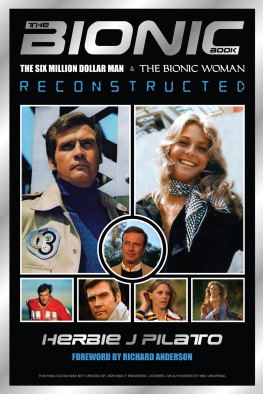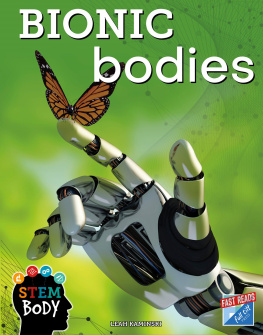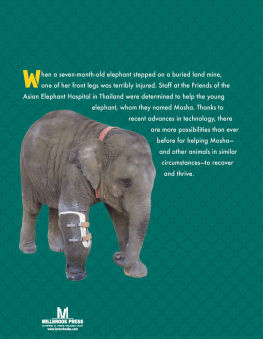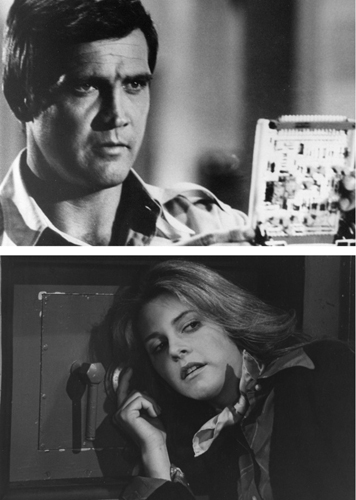Lee Majors, as Steve Austin, inspects a circuit board with his bionic left eye. Austin was also fitted with bionic replacements for his right arm and both legs after a horrifying plane crash. Lindsay Wagner, as Jaime Sommers, received a bionic right arm, legs, and implant in her right ear after a serious skydiving accident. Her bionic hearing frequently came in handy when cracking safes.
Man, Woman, Book and Machine
Steve Austin, The Six Million Dollar Man, and Jaime Sommers, The Bionic Woman, are not your average superheroes. As portrayed by Lee Majors and Lindsay Wagner, theyre heroes first, super, second. Through various incarnations, from the 1970s (on ABC and NBC) to the present (reruns of original episodes and reunion movies on cables Lifetime and Sci-Fi channels), this atomic-powered, romantically-entangled couple continues to inhabit the television airwaves.
In the initial 1973 ABC pilot film, Steve was the first cyborg (half-human/half machine), rebuilt (made betterstrongerfaster) by the American-based OSO (Office of Strategic Operations) after a freak accident. When the movie became a monthly, then weekly, series, he rekindled a romance with once-lost love Jaime. They planned to wed. She, too, was injured in a serious accident. Steve pleaded with his superiors to rebuild her, just like him. She, too, was given a hit series.
Millions of Bionic fans, general observers and those new to the genre, continue to perceive these programs beyond the contretemps of science fiction. Viewers the world over recognize and respect the unique covenant imparted by and between Steve and Jaime. Be it in France, Germany, Australia, or any number of disparate destinations, the devotion people have for this dynamic couple is evident. They hit a chord in the 1970s.
As children, todays thirty- and forty-somethings once aspired to run in bionic slow motion like Steve and Jaime; mimicked sound effects which accompanied his long-distanced-angled left eye; her sonar powered right ear. Viewers of all ages now continue the bionic legacy, as they still keep on liking and believing in bionic people, because the Austin/Sommers powers of persuasion continue to make bionic people likable and believable.
All these years later, one thing remains indelibly true: these shows were fun. It should be fun to be bionic, and it was. Waiting for the next episode to air was often sheer agony for younger viewers, who would eagerly break down the previous nights broadcast at school the next day. Fantastical and far-out plots and premises were played with a totally straight face, and we loved every minute of it. Rarities among the science fiction superhero hall of fame, The Six Million Dollar Man and The Bionic Woman prevail as real. Superman and Wonder Woman need never fear a rivalry, as they dont really exist.
Steve and Jaime are tangible. They care for one another, based upon their pre-cybernetic history, subsequent bionic transformation and distinct, yet combined, destinies. The home onlooker is encouraged (subconsciously or not) to seek sincerity at every turn; to stretch their reality, as well as their imagination; to see past contrarieties, and to focus on the common thread of humanity. TV viewers have sensed all along that these two were fundamentally human. Home observers continue to watch these programs not to laugh at camp, but to be entertained and moved.
As fictional government agents of decades-gone-by, the bionic duo was sent on special assignments, but their most important mission lingers into the present day. They introduced to the general public the bona fide possibility of workable prosthetics. A bionic bond was forged between fantasy and fact; between a farfetched TV concept and the medical visionaries who made good on the promise and potential of bionics.
Clearly, with SM and BW, the extraordinary communicative device known as television has been efficiently engaged. Steve and Jaime prove to be emphatic role models from whom we may ascertain strength. The real kind. The kind that lives inside us. The kind that allows us compassion and discretion; forgiveness and endurance. The human kind, motivated by the human spirit.
Through TVs majestic mechanics, and by observing the lives of a uniquely-created pair, struggling for personal identity while acclimating to their new physiology, the pressure to learn is off. Were charmed, and walk away with an inspirational thought and positive reinforcement in the process.
In keeping with the real-to-reel theme, the late, revered writer Martin Caidin (who passed away on March 24, 1997) was, well, a realist. His novel, Cyborg, first published in 1972, was the springboard for The Six Million Dollar Man, a tale of one mans triumph over spiritual ruin and Caidins prognostication on bionic erudition.
Born Martin Karl von Strasser, on September 14, 1927 in New York City, Caidin himself was somewhat of a superior individual.
A commercial and professional US Air Force pilot, teacher and lecturer (at Santa Fe College and the Institute of Advanced Studies, Nebraska), he had studied Atomic-Radiological-Biological-Chemical Warfare, and became a researcher and developer in bionics and telekinetics. He was also a radio and TV talk show host, a war correspondent, stunt pilot, an actor, a consultant to many publications and business firms (including the Air Force Missile Test Center and the FAA), a special agent for several law agencies, an Operative in the US Air Commandos, a parachutist, a military vehicle test driver, and a researcher with the Office of Paranormal Research.












